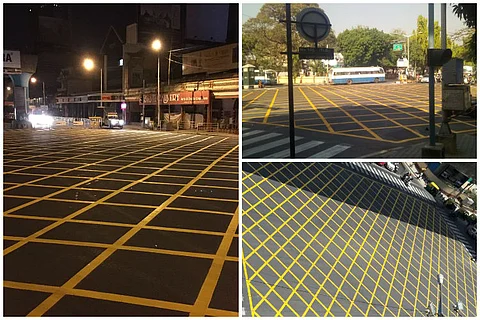

If you travel through Bengaluru’s busy Central Business District, you’ve probably spotted the yellow grid lines that have popped up in the well of a number of traffic junctions. If you don’t know what they mean and have ignored them thus far, it might be time to pay attention. Ignorance could burn deep holes in your pockets through heavy traffic fines.
According to the Bengaluru Traffic Police, these yellow criss-cross patterns are being painted across all heavily congested traffic junctions defined by the police as zero-tolerance zones. The yellow grids will help the police ensure that vehicles can move smoothly through, and pedestrians can easily cross these busy junctions.
How they work is fairly simple. The grid lines are painted to warn motorists not to stop in the well of junctions where they will impede the movement of traffic from other directions, and also get in the way of pedestrians moving across junctions.
Any vehicle that stops and stands on the yellow grid or is within the grid when the lights have turned yellow or red, will automatically be fined. And they cannot give the excuse that they were blocked by traffic ahead of them, as they are not supposed to move into the well of the junction unless the way is clear.
Vehicles are only allowed to stop on the yellow grid when they are turning right, if the vehicle ahead of them is also turning or while waiting for oncoming vehicles to pass.
Thanks to the traffic cameras installed at all of these junctions, the police say they will enforce the rules and fine violators even if there are no officers present on the spot.
“If the signal is green and your car is parked in the grid, then it will be a wrong parking offence. And if you have jumped the signal, you would be fined for jumping the traffic signal, and for reckless and dangerous driving,” Assistant Commissioner of Police (Traffic and Planning), Kasim Raja, told The News Minute.
According to the Traffic Police website, this would mean a fine of Rs 100 for either offence.
The senior official added that no tolerance will be shown to violators and there will be "no first time warnings" issued.
The rules against vehicles stopping in the middle of traffic junctions have always existed. But it’s only after the CBD roads were renovated under the TenderSure project that the police have begun explicitly marking junctions in order to enforce the rules strictly.
"The aim is to ensure pedestrian safety and decongest the city's junctions. The zigzag lines are meant for the safety of pedestrians. Motorists have this habit of parking or stopping their vehicles near the junction, thus blocking the vision of pedestrians crossing the road. If we are able clear the areas near pedestrian crossings, accidents can be brought down," R Hitendra, Additional Commissioner of Police (Traffic) was quoted as saying in a Times of India report.
Currently, there are 11 such grid painted junctions, including a few outside the CBD such as the Sony World Junction in Koramangala. The police plan to paint a total of 100 such crossing across the city in the coming months.
Already, the police have begun booking a large number of cases in this regard. A total of 1,800 offences related to these grid lines were registered on Saturday, March 26, alone.